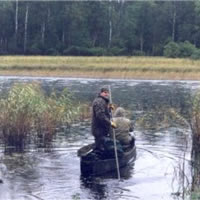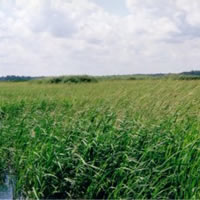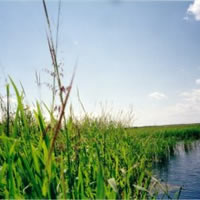Click here for Moose Lake Wild Rice nutritional information.
"Wild Rice is the most nutritive single food which the Indians of North America consume. The Indian diet of this grain, combined with maple sugar, and with bison, deer, and other meats, was probably richer than that of average American family of today." - Albert E. Jenkins, Wild Rice and The Ojibway People
The History of Wild Rice
Wild Rice is an aquatic cereal grain that grows "wild" in isolated lakes and river bed areas located primarily within the continent of North America. It is also native to ecologically similar regions located on the continent of Asia. This evolutionary ancient grain has been found in layers of the earth dating back some 12,000 years. In addition to its role as an important food staple for ancestral peoples, it has provided a unique habitat for fish and waterfowl for thousands of years.
Wild Rice is the grain of a reed-like aquatic plant (Zizania palustris), which is unrelated to rice. It is grown in the United States and also in Canada. The grains are long, slender and black, with a distinctive earthy, nutty flavor. It is available in three different grades: giant, which is a very long grain and the best quality; fancy, which is a medium grain and of lesser quality; and select, which is a short grain.
Wild Rice is an annual grass which grows naturally in many Northern Minnesota and Wisconsin lakes. The Chippewa word for grain or berry is "min". The word "mano", meaning good, makes "manomin" (good berry). Wild rice was known by th name manomin to the Chippewas and to most of the early white explorers and settlers of the Upper Mississippi Valley. Throughout the years, there have been 60 popular names identified for wild rice. English terms were numerous but the most commonly accepted name became wild rice. By whatever name, many of the Indigenous Peoples of North America consider the wild varieties of lake and river wild rice to be "A Gift from the Great Spirit...the Creator Himself", spiritually sacred and therefore distinct from the cultivated or farm grown varieties. Today, the wild varieties and the cultivated or farm grown varieties of wild rice remain an especially important crop for both lake and river producers and modern day farmers.
Manomin gave its name to the moon (month) of harvest, which is typically the end of August to early September in northern Minnesota. Harvest time can be fun, but a lot of hard work is involved, especially processing the grain on the spot, even with some modern aids. This native grass has a very large, erect, branched inflorescence which produces edible grains. Wild-rice usually grows in water and is often planted as wildlife food. Manomin grows as reeds that are anywhere from 8-12 ft. tall. They grow in water that is about 3-8 feet deep in Wisconsin, Minnesota, and marshes north of the Great Lakes. There are thousands of different varieties, each kind growing in its own particular place of depth, temperature, mud, water quality. Wild rice is very sensitive to the environmental conditions of its niche. The plants do not like changes; the species are perfectly adapted to the way things are in different areas, including seasonal water levels, quality, temperature.
Harvesting Wild Rice
The methods used to harvest rice have remained unchanged for centuries. A canoe is pushed through the rice beds with a long forked pole. The "poler" stands in the front, while the "knocker" sits in the rear of the canoe. The knocker uses two carved cedar sticks to harvest the rice grains. The knocker will use a stick to gently bend the rice stalks over the side of the canoe and the other stick to stroke or tap the rice kernels off the stalk. Some kernels fall into the water to re-seed the rice bed. Past generations would process the "green" rice at the landing using traditional methods. Today, the rice is put into large bags upon returning to the landing and taken to rice processing facilities.
Historically, rice was dried by spreading it out on birch bark or blankets on the ground and continuously raking it to allow the air and sun to dry it. The rice was allowed to dry for a day or two. Another method used was to spread the rice out on drying racks constructed from green branches and grass and then by placing the racks over the fire. With the introduction of the cast-iron kettle during the fur trade era, parching became the preferred drying method. The rice is roasted in a cast-iron kettle over a fire and stirred with a cedar paddle. Parchers know the rice is properly dried when they pinch a kernel between their fingers and the kernel breaks. Parching usually takes about an hour to complete. After parching, the rice kernel is further loosened from the hull by strenuous foot thrashing, also known as "jigging." The common method of jigging is to dig a small pit in the earth, line it with wood slats or a blanket, place a closed bag of rice into the pit, and start treading. To assist balance and help the treader control the amount of weight applied to the rice, two poles are placed alongside the pit in a V-shape. The final step in processing wild rice is "winnowing," or tossing the rice in the air. Using a winnowing basket, or "nooshkaachinaaganan," the rice is tossed in the air numerous times to allow the lighter weight chaff to blow away, leaving the rice kernels ready for cooking or long-term storage.
Wild rice was a staple food of American Indians. It is also a food for wild birds and waterfowl, especially mallard, bobolink, blackbirds, and Carolina rail. It has been a luxury food that has complimented wild game dishes for many years, but only when harvested from lakes and rivers. However, during the last fifteen years, since its cultivation, wild rice has become more plentiful and can be found in many stores. One of the most famous Indian dishes was tassimanonny, which is wild rice, corn, and fish boiled together. Perhaps its greatest fame is when it is used as side dish with (or inside) wild gamebirds, ducks, pheasants, quail, and turkeys. Aquatic birds readily stuff themselves with wild rice, which may constitute more than 10% of the stomach contents of black ducks, mallards, and wood ducks. Today, because of its increased abundance, wild rice is used in a variety of ways. It is used in place of potatoes, either alone or mixed with other rice, in soups, salads and even deserts.
A Closer Look:
| Wild rice was a staple food for the Sioux and Chippewa Indians. Minnesota's lakes and rivers produce most of the millions of pounds of wild rice harvested annually in Canada and the United States. |  |
| To prevent damage and loss of the crop, the boat or canoe is poled from the rear while the front man in the team, using what looks like oversized drum sticks, knocks the ripe rice from its stalk into the boat. |  |
| It takes two to three pounds of green (unprocessed) wild rice to yield one pound of finished (processed) wild rice. |  |
| Approximately 4/5ths of the seed falls back into the water to become seed for future crops and food for wildlife. |  |
The Uses of Wild Rice
…as a grain
Wild Rice is usually always sold as a dried whole grain. It is rich in carbohydrates, high in protein, the amino acid lysine and dietary fiber, but low in fat. It does not contain gluten. It is a terrific source of the minerals potassium and phosphorus, as well as the vitamins thiamine, riboflavin and niacin. Because of its texture and density, wild rice must be cooked longer than true rice to become soft enough to eat. It generally takes about 35-50 minutes to cook, when using a ratio of wild rice to water of approximately 1 to 3. Because of its high nutritional value and flavorful taste, wild rice has increased in popularity in the late 20th Century, and commercial cultivation began in the US and Canada to supply the increased demand. In the United States the main producers are California and Minnesota (where it is the official state grain) and it is mainly cultivated in paddy fields.
…as a Folk Medicine
Reported to be diuretic and refrigerant, Zizania palustris is known to be a folk remedy for burns, heart ailments, hepatoses, nephrosis, pulmonosis, and stomach ailments.
…as Ornamental use
Wild rice is also grown as an ornamental plant in garden ponds.
…as Cultural use
Several Native American cultures, such as the Ojibwa, consider wild rice (known as manoomin to the Objiwa) to be a sacred component in their culture. The rice is harvested by hand, with two people sitting in a canoe, one of them knocking rice into the canoe with a pole while the other paddles slowly. For these groups, these harvests are an important cultural and often economic event.
The Difference between what is known to many shoppers as 'organic wild rice' and 'cultivated wild rice' …
Most of the wild rice that is available in grocery stores across the country is referred to as paddy rice. This type of rice is grown similar to brown rice in rice paddies. It cooks uniformly, and is consistently the same year after year because it is cultivated rice. This type of rice is actually a hybrid developed by the University of Minnesota. It is for this reason that many people do not like true wild rice.
"Real" wild rice grows wild in the clear lakes where we live. It is not genetically modified and has not been altered like most of the other grains available in the US. This wild rice requires just the right conditions to grow and only grows naturally in northern Minnesota and in Canada just north of us. The water has to be at a certain level, and it needs to flow slightly, but not too much, so that it would uproot the plants. The bottom of the lake needs to have rich humus, and the temperatures need to be like those you see in this area of the country. When given those conditions you are able to grow delightfully nutritious, healthy and natural rice that is actually a grass with large seed heads. The water fowl are quite attracted to it as well.
Most of the grains we currently purchase in America such as wheat, brown rice, barley, soybeans and corn, have undergone years and years of hybridizing. Not one of these grains is natural anymore. Kamut is ancient wheat that was found in an Egyptian tomb. This was wheat, but much larger and much more nutritious than the wheat we currently have in America. All the other grains we use today other than quinoa, millet, amaranth and buckwheat have been tampered with. The real wild rice will not grow in rice paddies nor can it be cultivated. This is a natural grain, native to Minnesota, which is not a "farm crop" and can not be cultivated. While the hybrids grains have fewer nutrients than their ancestors, real wild rice is like those ancient grains. It grows on non depleted soils at the bottom of pristine lakes; it is planted naturally, and has the same nutritional value as it did years ago.
Once the rice is harvested it looks just like large green grass seed. These seeds are then parched to remove the husk.
There are many people who do not realize the marked difference between paddy-grown wild rice, and the real, wild, hand-harvested product that is often referred to as organic wild rice. Many people find that cultivated wild rice has a noticeably different flavor. But, among unknowledgeable consumers, the most obvious difference is the price between the two. Many who buy the cheaper cultivated rice never really discover this distinctive difference. The wild rice we sell is 100% naturally grown unless it is labeled 'Cultivated'. Neither is certified organic wild rice in accordance with the USDA regulations since it is grown in the wild lakes and rivers of Northern Minnesota and Canada not on a certified organic farm.
Storage
Wild rice will keep indefinitely, if it is kept in a cool dry place in a covered jar or left in original bag.
Cooked, leftover wild rice can be keep refrigerated up to one week; however, it is recommended that you use it up within two or three days. After one week left over wild rice can be frozen. Any cooked foods stored in the refrigerator for a week can develop molds and yeasts that are not visible to the eye but can negatively affect the immune system.